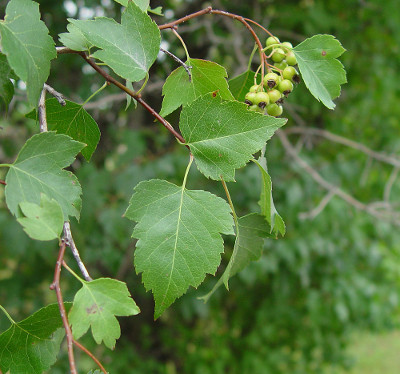Washington Hawthorn Tree
Category: Deciduous Trees

Facts about Washington Hawthorn Tree, "Scientific name for Washington Hawthorn Tree is Crataegus phaenopyrum". Washington Hawthorn Tree is a variety of flowering tree generally recognized as Washington Thorn Tree. The Washington Hawthorn Tree attained its name from its point of source when brought into Pennsylvania from Washington, turning out to be recognized as the "Washington Thorn" due to its famous thorns. This is an excellent famine tolerant tree. When fully grown, the Washington Hawthorn tree attains the shape of a pyramid.
Features of Washington Hawthorn Tree
The Washington Hawthorn Tree is a small, multicolored, flowering tree that will grow in any land. This ornamental tree offers beautiful, showy flowers that are white in color. The pleasant display of the tree starts with reddish-purple colored leaves coming into view in the spring season, and then, they become dark green in color when they are joined by an elegant display of white color flowers. The leaves of the tree will turn to scarlet, orange or purple color during the autumn season. Red berries of the tree extend the multicolored show into winter, habitually contrasting wonderfully with the initial winter snow. If left without trimmed, the thorns of the tree make an extremely efficient barrier.
A Full grown Washington Hawthorn Tree can absorb as much as 48 pounds (21.77 kg) of carbon dioxide a year. The same Washington Hawthorn Tree could also produce enough oxygen in a day for two people. In a single day, a large Washington Hawthorn Tree can drink up to 100 gallons (378.5 liter) of water from the ground and discharge it into the air.
You can tell a Washington Hawthorn Trees age by the number of growth rings. Growth rings size shows what kind of conditions accrued that year, the temperature and if it was a dry or wet year.
Bark of the Washington Hawthorn Tree protects it from the elements and is made up of dead cells.
Washington Hawthorn Tree roots usually grow two to three times the width of the tree branches. The ideal time to fertilize your Washington Hawthorn Tree is in late fall or early spring. If you want to transplant a Washington Hawthorn Tree do it in fall, this is ideal for most trees.
The Washington Hawthorn Tree is extensively developed as an ornamental plant, and can attain the height, ranging from 25 to 30 feet (7.62 to 9.14 meters), with the maximum spread of 25 feet (7.62 meters). The Washington Hawthorn tree grows at an average growth rate and performs well in complete sunlight. The Washington Hawthorn Tree grows well in alkaline, acidic, loamy, wet, well drained, sandy and clay soils.
Washington Hawthorn Tree leaves are made up of many colored pigments, green chlorophyll hides the colors during the growing season of spring and summer. As days get shorter and cooler temperatures come in the fall, it cause the chlorophyll to break down and than the other color pigments can be seen.
Washington Hawthorn Tree growth is referred to as Meristem (The undifferentiated embryonic plant tissue from which new cells are created, as that at the tip of a root or stem). This tissue can be found at the tips of shoots and leaves. Inside the stem growth in thickness occurs at the vascular cambium.
Washington Hawthorn Trees make their own food from sunlight, carbon dioxide, water, and nutrients from the soil.
Uses of Washington Hawthorn Tree
The Washington Hawthorn tree produces copious fruits, which are consumed by birds and animals. It is a significant nectar plant for bees. The small fruit of the Washington Hawthorn Tree, which is similar to a red berry fruit, grows closely together in big clusters and are a favorite food for birds and squirrels. The fruits of the Washington Hawthorn Tree have a mild taste and can be consumed raw or cooked. Like with other variety of hawthorn, the wood of the tree is hard and can be exploited to make tools.
The average lifespan of the Washington Hawthorn Tree ranges from 50 years to 150 years.

 Back To Category Deciduous Trees
Back To Category Deciduous Trees